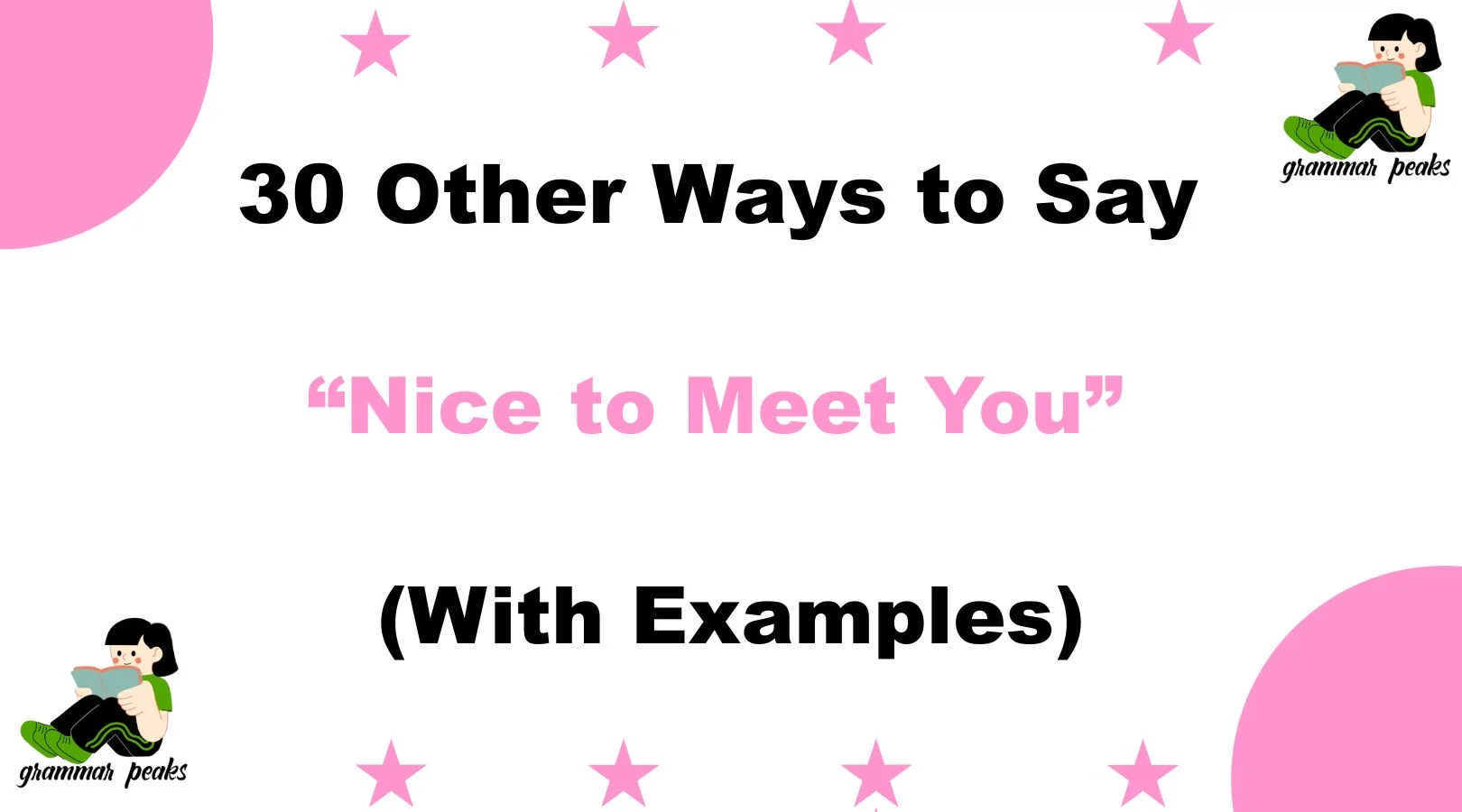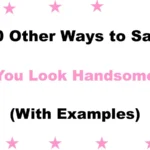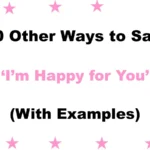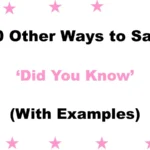Meeting someone new is more than just an exchange of greetings—it’s an opportunity to forge a connection, convey genuine warmth, and set the tone for the relationship ahead. While the phrase “Nice to meet you” is friendly and familiar, sometimes you want to add a personal touch or vary your expression to suit the moment.
In this article, you’ll discover 30 alternatives that help you sound empathetic, thoughtful, and engaging, along with clear explanations, real-world scenarios, and guidance on when (and when not) to use each.
Whether you’re networking, socializing, or just making small talk, these expressions will help you communicate with authenticity and care—making every introduction feel a little more special.
What Does “Nice to Meet You” Mean?
The phrase “Nice to meet you” is a polite and friendly expression commonly used when you’re introduced to someone for the first time. It signals that you’re pleased to make their acquaintance and helps set a warm, respectful tone for the conversation.Whether used in professional or personal settings, it’s a way of showing courtesy, openness, and interest in connecting with the other person.
Although it’s a simple phrase, it carries emotional weight—it acknowledges the start of a potential relationship, no matter how brief or lasting. Over time, however, its frequent use has made it feel a bit automatic, which is why many people seek more thoughtful, genuine alternatives that reflect their personality or the context more accurately.
When to Use “Nice to Meet You”
- First introductions: Formal or informal, especially when meeting someone in person.
- Networking events: To establish initial rapport.
- Customer interactions: Greeting clients or service providers.
Tip: Pair it with a smile and eye contact for maximum warmth.
Is It Professional/Polite to Say “Nice to Meet You”?
Yes—“Nice to meet you” is widely accepted in both professional and social settings. It strikes the right balance between formality and friendliness, making it a versatile greeting.
Pros and Cons
Pros:
- Universally understood.
- Suitable for most contexts.
- Conveys basic warmth.
Cons:
- Can feel impersonal if overused.
- Lacks specificity or deeper emotional nuance.
Synonyms for “Nice to Meet You”
- Pleased to meet you
- It’s a pleasure to meet you
- Glad to make your acquaintance
- Delighted to meet you
- Happy to meet you
- Great to meet you
- Charmed to meet you
- Thrilled to meet you
- Honored to meet you
- Lovely to meet you
- Good to meet you
- What a pleasure meeting you
- I’ve been looking forward to meeting you
- Wonderful to make your acquaintance
- Glad our paths crossed
- Nice meeting you
- Happy to have the chance to meet you
- It’s great to finally meet you
- Pleasure meeting you at last
- I’m glad we finally met
- Fantastic to meet you
- Wonderful to meet you
- Glad to e-meet you
- It’s great to connect
- It’s a joy to meet you
- Thrilled to connect
- Pleased to make your acquaintance
- So good to meet you
- Happy to connect with you
- It’s wonderful crossing paths
1. Pleased to meet you
Definition: Expresses genuine happiness at the introduction.
Detailed Explanation: Warmer than “nice,” it signals enthusiasm.
Scenario Examples: At a client meeting: “Pleased to meet you, Ms. Patel.”
Best Use: Formal settings where you want to show enthusiasm.
Worst Use: Very casual contexts—it can feel overly formal.
Tone: Warm, enthusiastic.
2. It’s a pleasure to meet you
Definition: Emphasizes pleasure taken in the introduction.
Detailed Explanation: Polished and respectful.
Scenario Examples: Networking: “It’s a pleasure to meet you—I’ve heard great things about your work.”
Best Use: Professional events, interviews.
Worst Use: In relaxed, casual meet-ups.
Tone: Respectful, polished.
3. Glad to make your acquaintance
Definition: More formal, slightly old-fashioned way of saying nice to meet you.
Detailed Explanation: Conveys courteous respect.
Scenario Examples: Formal dinner: “Glad to make your acquaintance, Mr. Thompson.”
Best Use: Diplomatic or very formal introductions.
Worst Use: Everyday casual meetings.
Tone: Courteous, formal.
4. Delighted to meet you
Definition: Expresses high delight at the meeting.
Detailed Explanation: Conveys genuine excitement.
Scenario Examples: At a conference: “Delighted to meet you—I admire your research.”
Best Use: When you truly respect or look forward to meeting someone.
Worst Use: If you don’t know them—can feel insincere.
Tone: Excited, genuine.
5. Happy to meet you
Definition: Casual and friendly version.
Detailed Explanation: Feels relaxed and personal.
Scenario Examples: Social gathering: “Hey, happy to meet you! I’ve heard so much about you.”
Best Use: Casual settings, parties.
Worst Use: Highly formal business meetings.
Tone: Friendly, casual.
6. Great to meet you
Definition: Positive, upbeat greeting.
Detailed Explanation: Conveys energy and friendliness.
Scenario Examples: Team meeting: “Great to meet you, welcome aboard!”
Best Use: Team-oriented or informal professional settings.
Worst Use: Ultra-formal contexts.
Tone: Upbeat, friendly.
7. Charmed to meet you
Definition: Playful and polite.
Detailed Explanation: Slightly whimsical, conveys delight.
Scenario Examples: Creative industries: “Charmed to meet you—love your portfolio.”
Best Use: Creative or less formal professional gatherings.
Worst Use: Very conservative workplaces.
Tone: Playful, polite.
8. Thrilled to meet you
Definition: Strong excitement at the meeting.
Detailed Explanation: Indicates you’re genuinely thrilled.
Scenario Examples: Celebrity meetup: “I’m thrilled to meet you—I’m a huge fan.”
Best Use: When you admire someone or in dynamic environments.
Worst Use: If it feels exaggerated in a simple introduction.
Tone: Enthusiastic, dynamic.
9. Honored to meet you
Definition: Shows respect and privilege.
Detailed Explanation: Implies the person is notable or respected.
Scenario Examples: Meeting a mentor: “Honored to meet you, Professor Lin.”
Best Use: When meeting someone you respect deeply.
Worst Use: Casual social events.
Tone: Respectful, reverential.
10. Lovely to meet you
Definition: Warm and gentle greeting.
Detailed Explanation: Conveys sweetness and warmth.
Scenario Examples: Small gatherings: “Lovely to meet you, Sarah.”
Best Use: Informal social events.
Worst Use: Very formal business settings.
Tone: Warm, gentle.
11. Good to meet you
Definition: Simple, neutral variation.
Detailed Explanation: Less effusive, still friendly.
Scenario Examples: Quick introductions: “Good to meet you, John.”
Best Use: Brief or passing encounters.
Worst Use: If you want to show warmth.
Tone: Neutral, efficient
12. What a pleasure meeting you
Definition: Highlights the pleasure taken in meeting.
Detailed Explanation: Adds emphasis to the joy of the encounter.
Scenario Examples: After a productive meeting: “What a pleasure meeting you today.”
Best Use: Concluding introductions.
Worst Use: At the very start of a conversation.
Tone: Reflective, warm.
13. I’ve been looking forward to meeting you
Definition: Indicates prior anticipation.
Detailed Explanation: Shows you value the meeting.
Scenario Examples: Scheduled interview: “I’ve been looking forward to meeting you, Ms. Rivera.”
Best Use: Pre-planned, awaited introductions.
Worst Use: Spontaneous encounters.
Tone: Earnest, anticipatory.
14. Wonderful to make your acquaintance
Definition: Polished and slightly formal.
Detailed Explanation: Conveys delight and respect.
Scenario Examples: Business dinner: “Wonderful to make your acquaintance, Mr. Davis.”
Best Use: Formal events with new contacts.
Worst Use: Casual settings.
Tone: Polished, respectful.
15. Glad our paths crossed
Definition: Reflective and personal.
Detailed Explanation: Implies serendipity.
Scenario Examples: Event meetup: “Glad our paths crossed at today’s seminar.”
Best Use: Networking events.
Worst Use: Very formal business meetings.
Tone: Reflective, personal.
16. Nice meeting you
Definition: Past-tense variation.
Detailed Explanation: Often used at the end of a conversation.
Scenario Examples: After a chat: “Nice meeting you—let’s stay in touch.”
Best Use: Concluding interactions.
Worst Use: At the very start of the meeting.
Tone: Pleasant, casual.
17. Happy to have the chance to meet you
Definition: Emphasizes opportunity.
Detailed Explanation: Shows gratitude.
Scenario Examples: Volunteer event: “Happy to have the chance to meet such dedicated individuals.”
Best Use: Group introductions.
Worst Use: Quick one-on-one intros.
Tone: Grateful, warm.
18. It’s great to finally meet you
Definition: Indicates it’s a long-anticipated meeting.
Detailed Explanation: Conveys relief and excitement.
Scenario Examples: Virtual friends meeting in person: “It’s great to finally meet you after chatting online.”
Best Use: Meeting online friends, long-planned intros.
Worst Use: Random, unplanned encounters.
Tone: Excited, relieved.
19. Pleasure meeting you at last
Definition: Highlights delay before meeting.
Detailed Explanation: Polite, slightly formal.
Scenario Examples: Delayed introductions at event: “Pleasure meeting you at last, Dr. Kim.”
Best Use: When introductions were postponed.
Worst Use: On-the-spot meetings.
Tone: Polite, formal.
20. I’m glad we finally met
Definition: Reflects happiness that the meeting happened.
Detailed Explanation: Conveys satisfaction.
Scenario Examples: After formal intro: “I’m glad we finally met, it’s been overdue.”
Best Use: Follow-up meetings.
Worst Use: First impressions.
Tone: Sincere, warm.
21. Fantastic to meet you
Definition: High-energy greeting.
Detailed Explanation: Conveys excitement and positivity.
Scenario Examples: Creative workshop: “Fantastic to meet you—I love your ideas.”
Best Use: Energetic, creative settings.
Worst Use: Conservative professional contexts.
Tone: Energetic, upbeat.
22. Wonderful to meet you
Definition: Warm and positive.
Detailed Explanation: Less formal than “pleasure,” more heartfelt.
Scenario Examples: After pleasant chat: “Wonderful to meet you—your insights were inspiring.”
Best Use: Casual-professional interactions.
Worst Use: Very formal events.
Tone: Warm, positive.
23. Glad to e-meet you
Definition: Virtual greeting.
Detailed Explanation: Used in email or online introductions.
Scenario Examples: First email exchange: “Hi Alex—glad to e-meet you!”
Best Use: Digital communications.
Worst Use: In-person meetings.
Tone: Casual, friendly.
24. It’s great to connect
Definition: Emphasizes building a connection.
Detailed Explanation: Suitable for both online and offline.
Scenario Examples: LinkedIn message: “Thanks for connecting—it’s great to connect!”
Best Use: Networking platforms.
Worst Use: Personal social events.
Tone: Professional, warm.
25. It’s a joy to meet you
Definition: Conveys delight.
Detailed Explanation: Nearly poetic, heartfelt.
Scenario Examples: Creative collaboration: “It’s a joy to meet you—your work is so inspiring.”
Best Use: Artistic or deeply personal contexts.
Worst Use: Formal corporate settings.
Tone: Poetic, heartfelt.
26. Thrilled to connect
Definition: Expresses excitement at connection.
Detailed Explanation: Blends meeting and networking.
Scenario Examples: Startup pitch meeting: “Thrilled to connect and explore collaboration.”
Best Use: Business networking.
Worst Use: Very casual meetups.
Tone: Enthusiastic, proactive.
27. Pleased to make your acquaintance
Definition: Formal, courteous.
Detailed Explanation: Traditional expression of respect.
Scenario Examples: Diplomatic event: “Pleased to make your acquaintance, Ambassador Lee.”
Best Use: Highly formal gatherings.
Worst Use: Informal or casual contexts.
Tone: Courteous, formal.
28. So good to meet you
Definition: Warm and casual.
Detailed Explanation: Conveys a sense of comfort.
Scenario Examples: Community meetup: “So good to meet you, I’ve heard great things.”
Best Use: Friendly social events.
Worst Use: Very formal business contexts.
Tone: Casual, warm.
29. Happy to connect with you
Definition: Focuses on connection.
Detailed Explanation: Suited to both online and in person.
Scenario Examples: Networking breakfast: “Happy to connect with you over coffee.”
Best Use: Professional networking.
Worst Use: Informal personal gatherings.
Tone: Professional, amicable.
30. It’s wonderful crossing paths
Definition: Implies serendipitous meeting.
Detailed Explanation: Reflects chance encounter delight.
Scenario Examples: Conference hallway: “It’s wonderful crossing paths like this.”
Best Use: Unexpected encounters.
Worst Use: Planned meetings.
Tone: Reflective, pleasant.
FAQs
1. What is a better way to say “Nice to meet you”?
A better way depends on tone and setting. You can say “It’s a pleasure to meet you” in formal settings, or “Glad we connected” for a warm, conversational tone.
2. Can I use “Nice to meet you” in professional emails?
Yes, but alternatives like “It’s a pleasure making your acquaintance” or “I’ve been looking forward to this conversation” can sound more professional and polished.
3. Is “Nice to meet you” outdated or informal?
Not at all. It’s still widely used and accepted, though using a more specific or thoughtful phrase can feel more intentional and sincere.
4. How do I say “Nice to meet you” in a more unique or memorable way?
Try phrases like “Meeting you has been a highlight” or “So glad our paths crossed”—they add warmth and a personal touch to the interaction.
5. What should I say instead of “Nice to meet you” in a virtual meeting?
Great virtual-friendly alternatives include “Great to e-meet you”, “Thank you for taking the time today”, or “Excited to connect online”, which acknowledge the digital context while still sounding professional.
Conclusion
Finding the right words to replace “Nice to meet you” isn’t just about variety—it’s about expressing sincerity, intention, and warmth in every interaction. Whether you’re greeting someone in a professional setting, a casual conversation, or even virtually, the phrases you choose can shape how you’re remembered.
By using more thoughtful, meaningful alternatives, you show that you value the connection and are present in the moment. Language has power, and when you replace common phrases with more personalised expressions, your communication becomes more engaging and human. With the 30 alternatives we’ve explored, you now have a rich toolbox of empathetic, professional, and creative ways to make that first impression genuinely memorable.






